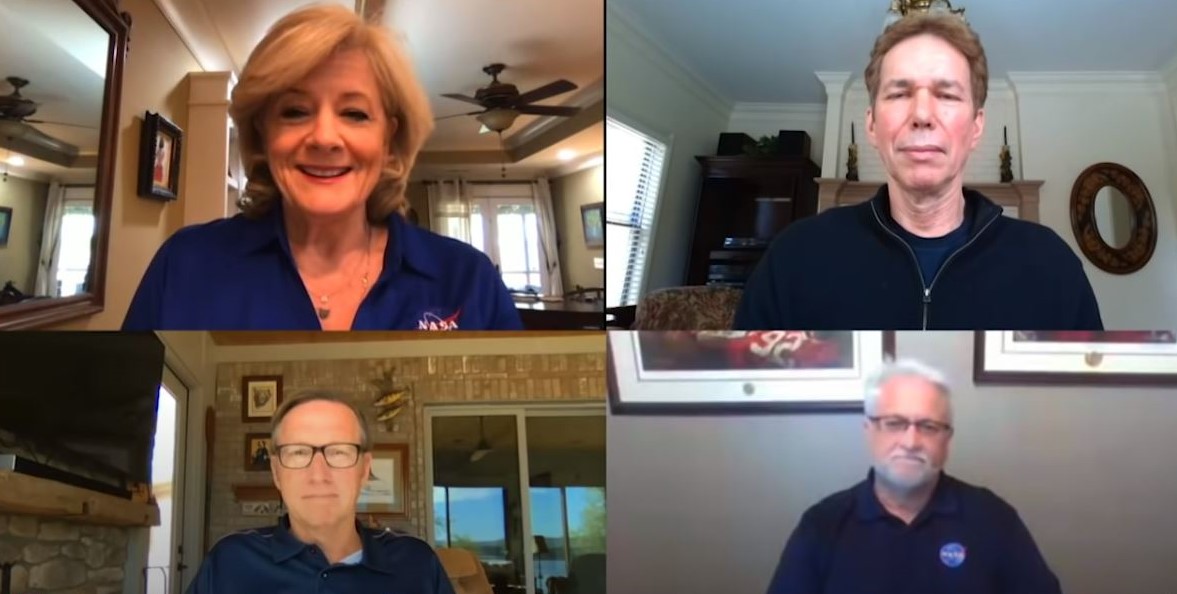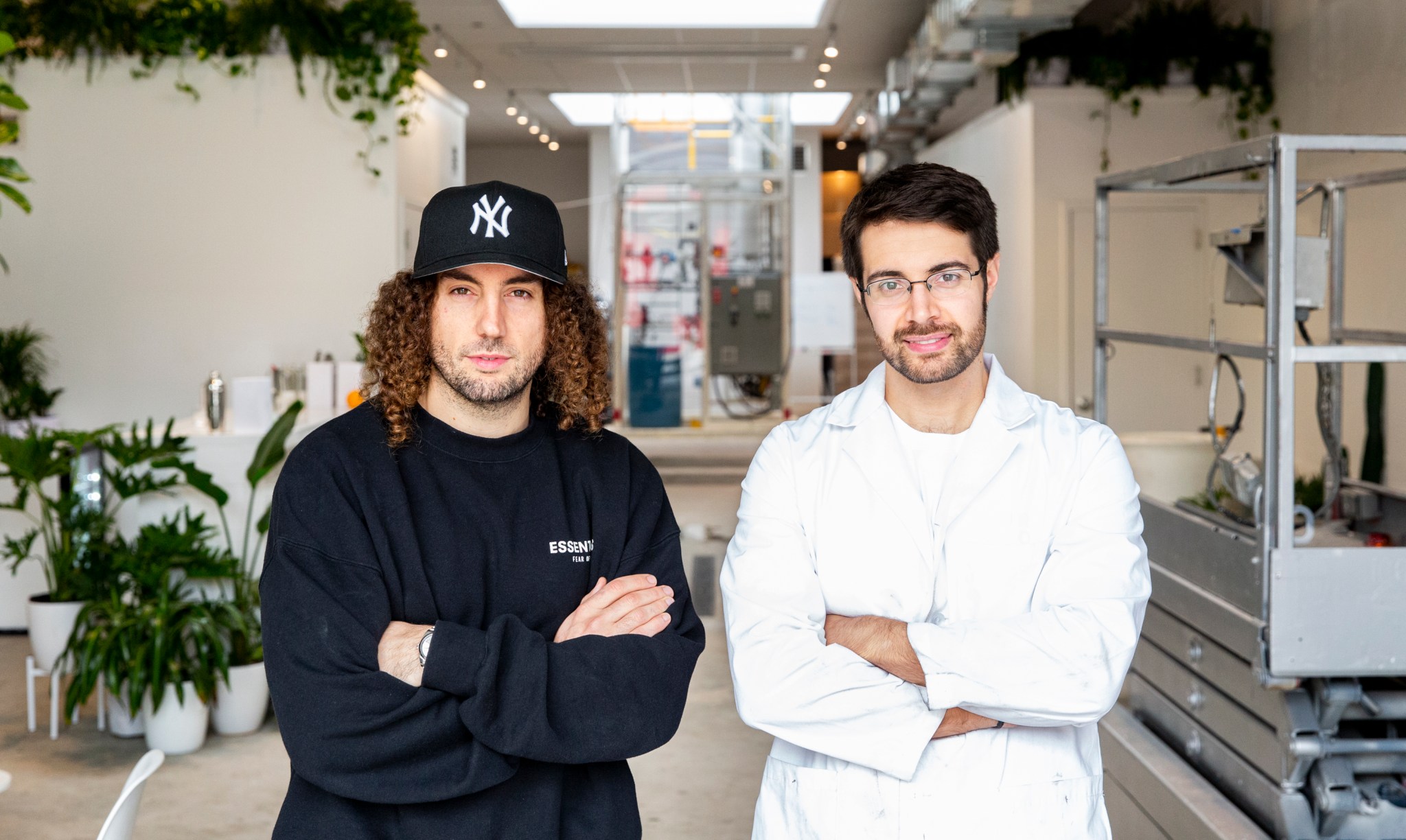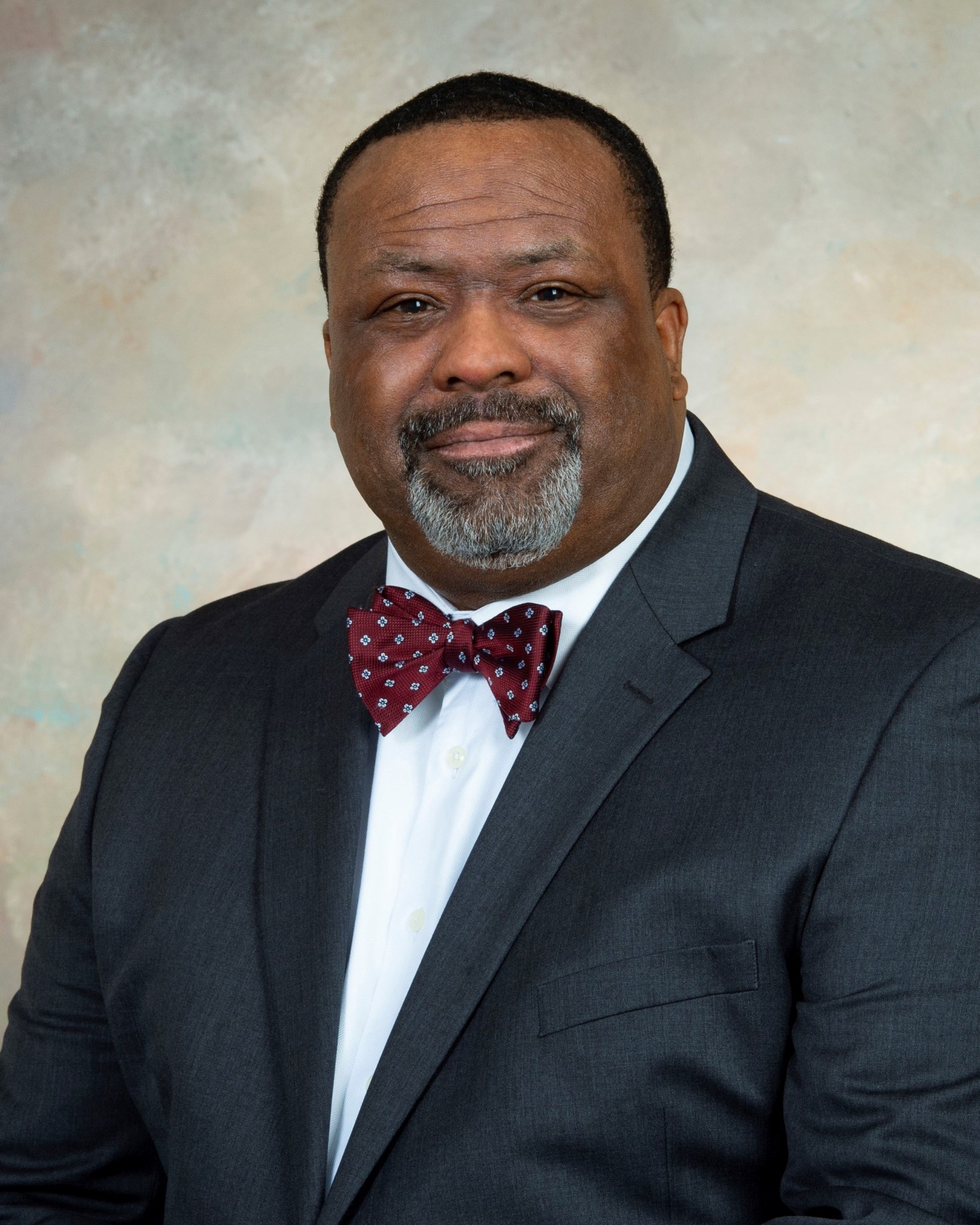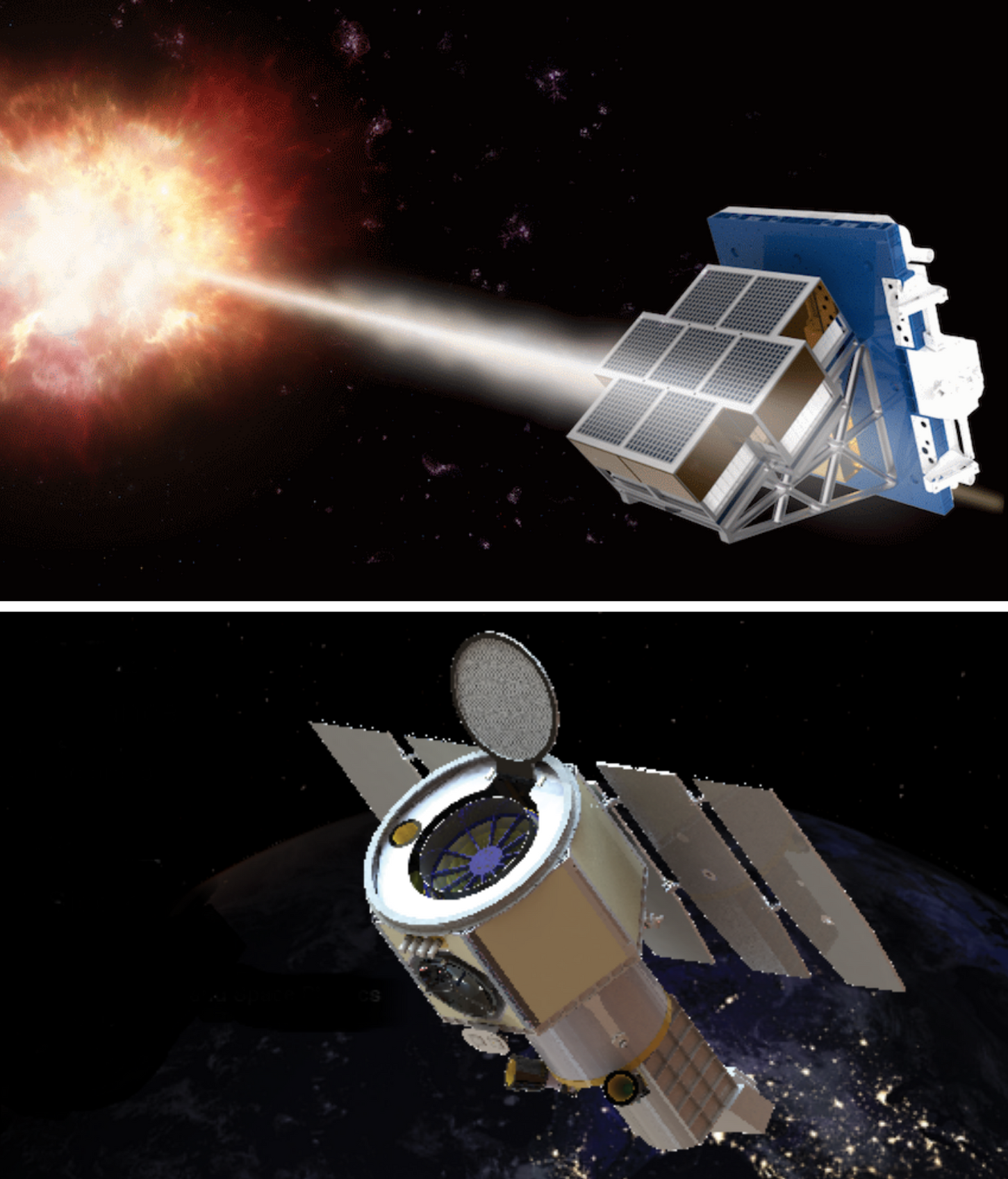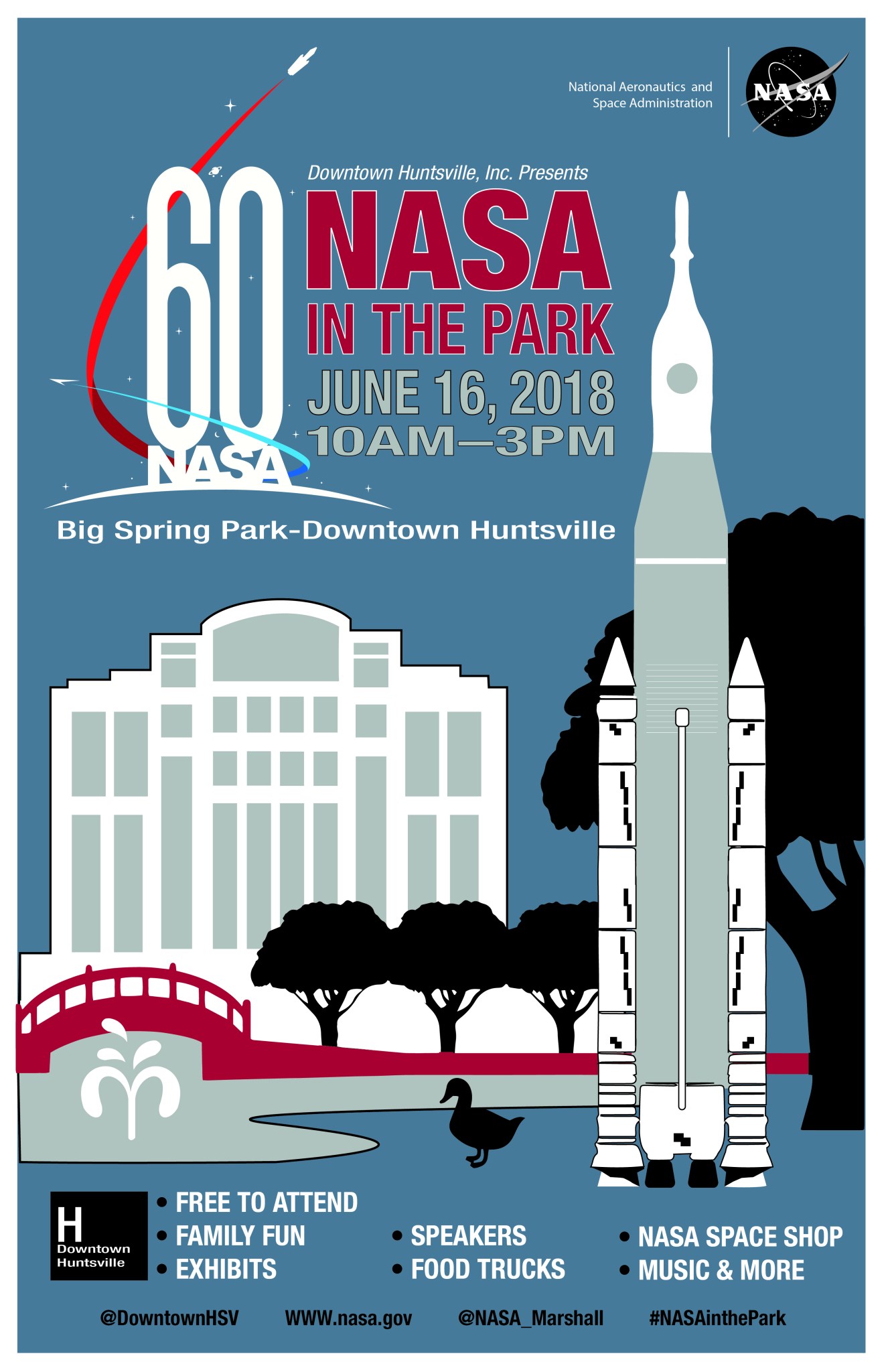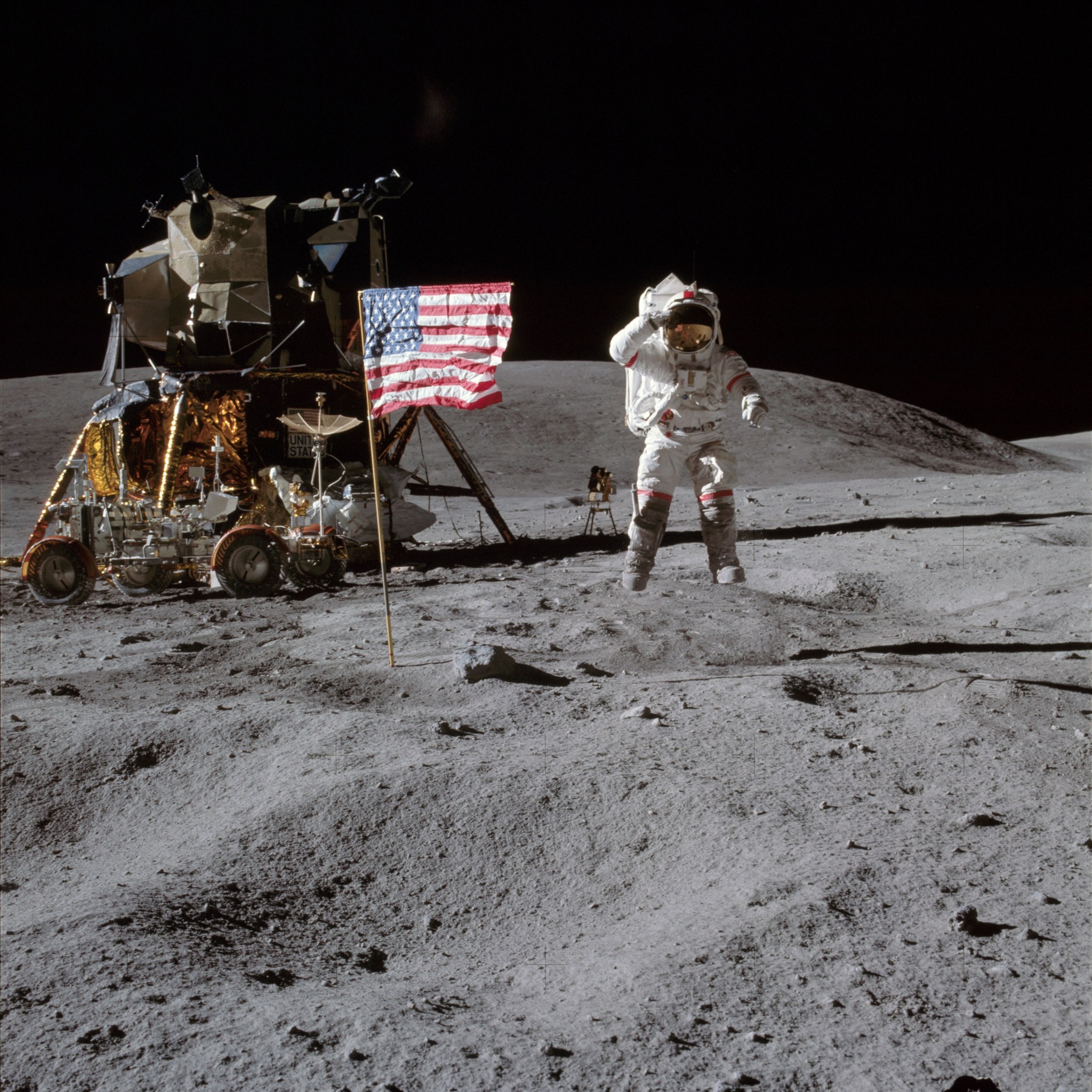In This Week’s Star
- Marshall Leadership Updates Team Members Via Virtual Town Hall
- NASA CO2 Conversion Challenge Competitor Helps COVID-19 Efforts
- Dwight Mosby Appointed to Space Station Payload Ops Leadership Roles
- NASA, SpaceX Simulate Upcoming Commercial Crew Mission
- Marshall Contributes to Pair of Proposals to Study Volatile Stars, Cosmic Collisions
- ‘Adversity in the Workplace’ Mentoring Event Set for April 21
- Team Members Encouraged to Think Green, Celebrate ‘Earth Day at Home’
- STEM Office Works to Award Student Launch, Rover Challenge Teams
- Apollo 13: The Successful Failure
- This Week in NASA History: Apollo 16 Launches – April 16, 1972
Marshall Leadership Updates Team Members Via Virtual Town Hall
By Taylor Goodwin
NASA’s Marshall Space Flight Center held its first entirely virtual town hall meeting April 2 as the center prepared to enter its fourth consecutive week of telework in response to COVID-19.
“This is a first for me,” Marshall Director Jody Singer said in the recording, “but I am thankful that we have the technology to allow us to connect from anywhere.”
As Marshall’s leadership team works on establishing live capability for centerwide town halls, they’re planning to continue airing prerecorded editions similar to the initial video — which included messages from Singer, Marshall Deputy Director Paul McConnaughey, Marshall Associate Director Steve Miley and Marshall Occupational Health Officer David Thaxton.
“I know this is not the ideal work situation,” Singer said. “Our work is that of humankind, and we are getting our jobs done the best way we know how. This virus is dictating our timeline, and we must allow data to drive our decisions. I will not authorize a partial or full return to the worksite until it is deemed safe to do so.”
Singer elaborated on changes that the workforce is experiencing in Stage 4 of the NASA Response Framework — which requires mandatory telework and the closing of facilities except to protect life and crucial infrastructure. The only team members allowed to be on-site are those necessary to protect and preserve infrastructure, information technology including agency communications and applications, and protective services. Additionally, team members whose work is deemed mission-critical to the safety of NASA astronauts or preparing for upcoming missions to the International Space Station are allowed to work on-site. The number of these employees working at the center has decreased by placing several team members on an “on-call” status.
Programmatic impacts of telework, Singer reported, include the suspension of production and testing of NASA’s Space Launch System and Orion at NASA’s Stennis Space Center, NASA’s Michoud Assembly Facility and Marshall.
There have been no significant impacts to science happening on the space station, and NASA’s Human Landing Systems team is continuing to move forward in their work. Further, Marshall is maintaining growth with virtual public outreach and virtual onboarding of new employees.
“We have a mission to accomplish,” Singer said. “We are enablers of exploration and discovery for all of humankind. The things we accomplish together will outlast this pandemic and any adversity that comes our way.”
Thaxton commended Marshall’s response to the pandemic, reporting that the center had only three confirmed cases — two of which occurred after mandatory telework was implemented. He reminded viewers that the best way to prevent illness is to avoid exposure. Individuals should frequently wash their hands with soap and water for at least 20 seconds. When traditional hand-washing is not possible, use hand sanitizer with at least 60% alcohol. Avoid touching the face, eyes, nose and mouth with unwashed hands. If an individual believes they are infected, they should self-quarantine for at least 14 days.
“When we return to the work site, we want to maintain these habits as best we can,” Thaxton said.
Singer is also maintaining communication with industry and community stakeholders. On April 9, she provided updates to the National Space Club during its board meeting teleconference.
“We’re all experiencing this new normal,” Singer said. “At Marshall, we’re having consistent tag-ups with all supervisors — discussing the steps in reopening the center and what social distancing strategies may be needed, sharing information with the contract workforce and implementing liberal telework and leave policies for workforce dealing with homeschooling and families. We’re being responsive and have learned how agile our workforce can be.”
Singer and Marshall leaders will answer questions from the workforce in the second virtual town hall event to be recorded later this week. Team members should continue to monitor NASAPeople and Inside Marshall for important information. For those unable to access the VPN, center-specific sections are available on NASAPeople for Marshall and Michoud.
Goodwin, an ASRC Federal/Analytical Services employee, supports the Office of Strategic Analysis & Communications.
NASA CO2 Conversion Challenge Competitor Helps COVID-19 Efforts
By Amanda Adams
A technology that could help humans live on Mars is being used to address an immediate need here on Earth and produce hand sanitizer for a community impacted by the coronavirus. Air Co., a company based in Brooklyn, New York, and competing in NASA’s CO2 Conversion Challenge, is making hand sanitizer with a technology that coverts carbon dioxide into ethanol. The company donates the supplies to local hospitals, doctors’ offices and police stations.
Air. Co. is using the same unique technology to convert carbon dioxide into simple sugar molecules known as D-sugars for the competition, part of the NASA Centennial Challenges program, managed by the Space Technology Mission Directorate at NASA’s Marshall Space Flight Center. The ability to make D-sugars, such as glucose, in space could be used to create mission-critical products, such as plastic, food and medicine.
“It is great to hear about a team participating in a NASA challenge using their technology to help their local area during this crisis,” said Walt Engelund, deputy associate administrator for programs within NASA’s Space Technology Mission Directorate. “This is one example of how NASA challenges spur innovation to help life on Earth and beyond. We catalyze a culture of change makers and problems solvers, many of whom go on to apply their technology and creativity to make a difference in their own communities and around the world.”
In addition to helping solve space exploration challenges, NASA prize competitions benefit participants too, enabling them to network, scale up ideas, increase resources and even launch companies.
Air Co. was one of five winners in the first phase of the CO2 Conversion Challenge, in which teams developed a concept to turn carbon dioxide into glucose using a nonbiological process. The team won $50,000 and is currently participating in Phase 2, the demonstration phase when they will build and demonstrate a system to help enable long-duration space exploration.
“A key feature of Air Co.’s process that made them successful in Phase 1 of the competition is that the initial production of alcohols from CO2 creates a valuable feedstock for making more complex compounds like sugars,” said John Hogan, a life support systems scientist at NASA’s Ames Research Center. “This also allows the alcohols to be used as is for immediately practical uses such as hand sanitizer.”
The company’s system combines CO2 with water, which first divides the water molecules into hydrogen and oxygen, then combines the hydrogen with CO2 to produce the carbon-negative alcohol used in the hand sanitizer. For the NASA challenge, the alcohol will then be used to create glucose.
Air Co. leveraged partners to create packaging and labeling for the hand sanitizer and is now working around-the-clock to produce approximately 2,000, 2-ounce bottles per week. The company plans to continue production as long as it’s needed.
Adams, an ASRC Federal/Analytical Services employee, supports Marshall’s Office of Strategic Analysis & Communications.
Dwight Mosby Appointed to Space Station Payload Ops Leadership Roles
Dwight Mosby has been appointed to a pair of leadership roles within International Space Station payload operations at NASA’s Marshall Space Flight Center.
Mosby was selected for the Senior Executive Service position of payload operations cost account manager, as well as manager of the Payload and Mission Operations Division. The Senior Executive Service is the personnel system covering most of the top managerial positions in federal agencies.
Mosby brings 23 years of requirements management, avionics, program management, configuration management and earned value management experience in the aerospace industry. He was previously manager of the Operations Directors Office, where he oversaw day-to-day operations of space station payloads and was the single point of authority to the station’s Flight Director’s Office in Houston for all of NASA’s payload operations.
Before joining Marshall, Mosby held multiple positions with Teledyne Brown Engineering in Huntsville, including manager of space station Training and Crew Operations; program manager for space station Mission Operations and Integration; senior director of Space Mission Operations; and, most recently, vice president of Space Operations. Previously, Mosby worked for United Space Alliance in Huntsville, where as a multi-purpose logistics module instructor he developed payload training lessons for station crew members and was responsible for developing standard operating procedures for joint station training operations conducted between Marshall and NASA’s Johnson Space Center.
Mosby earned bachelor’s and master’s degrees in physics from Clark Atlanta University and a doctorate in civil engineering from the University of Nebraska in Lincoln. He has been awarded two NASA Group Achievement Awards, three NASA Certificates of Achievements, a Silver Snoopy, a Space Flight Awareness Team Award, a President’s Volunteer Service Award, a NASA Office of Small Business Program’s Large Prime Business of the Year award and he was named NASA Office of Small Business Program’s Mentor-Protégé of the Year in 2016.
A native of Pittsburgh, Mosby and his wife have two sons and reside in Huntsville.
NASA, SpaceX Simulate Upcoming Commercial Crew Mission
Joint teams from several NASA centers and SpaceX continue making progress toward the first commercial crew flight test with astronauts to the International Space Station, completing a series of mission simulations from launch to landing.
The mission, known as Demo-2, will be a close mirror of the March 2019 SpaceX uncrewed flight test to station — but this time with NASA astronauts Bob Behnken and Doug Hurley aboard the Crew Dragon spacecraft launching atop a Falcon 9 rocket as part of NASA’s Commercial Crew Program.
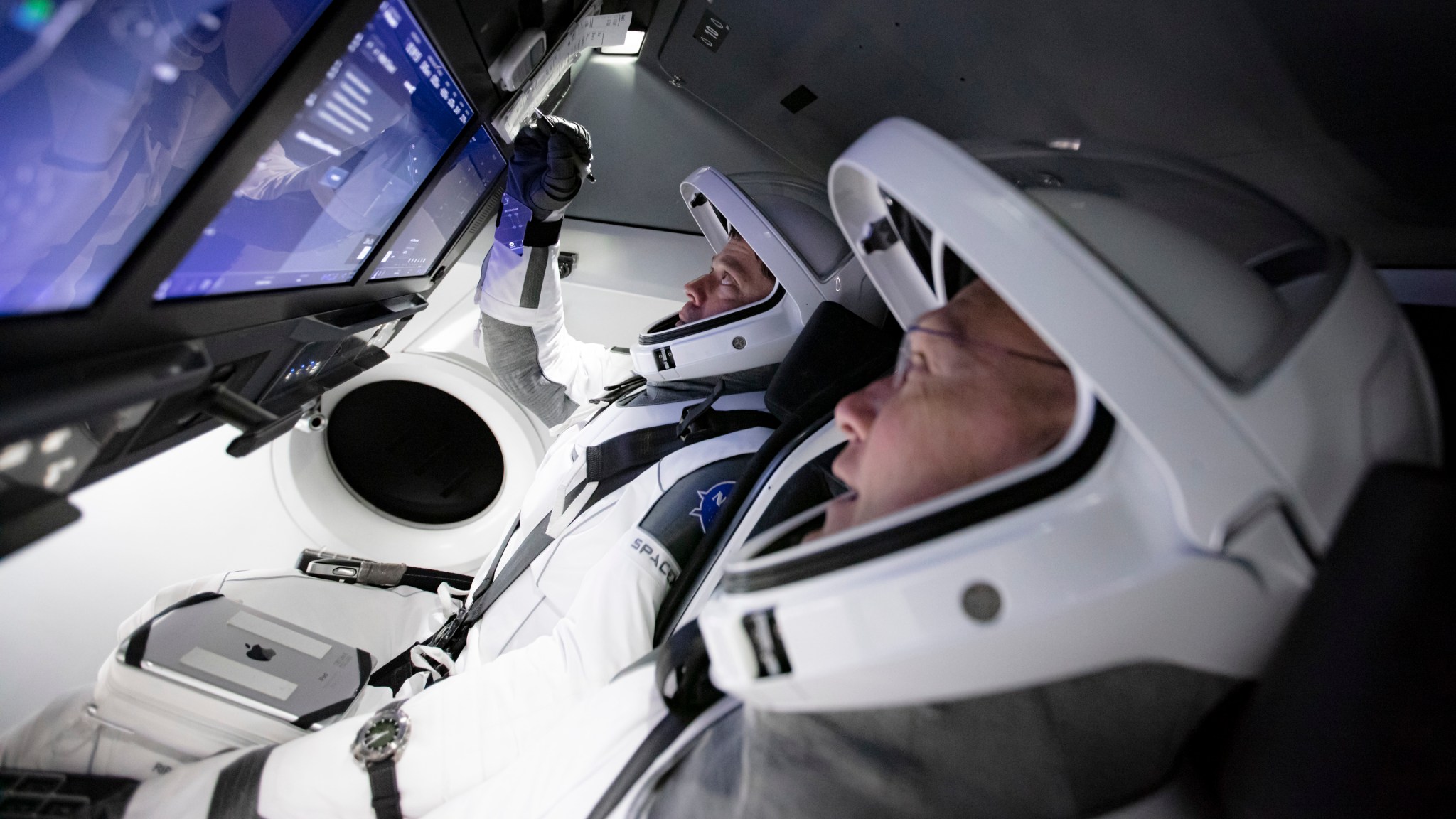
On April 8, a team at NASA’s Marshall Space Flight Center, along with key members of flight control teams working from NASA’s Johnson Space Center and Kennedy Space Center, and SpaceX headquarters in Hawthorne, California, simulated different phases of the upcoming mission.
The Marshall team was set up in NASA’s Huntsville Operations Support Center, at socially-distanced console positions. During the simulation, participants used headsets and voice loops to communicate with multiple locations across the United States.
“Using the HOSC for the simulations protected our employees by not having to travel during the COVID-19 pandemic,” said Steve Gaddis, launch vehicle deputy manager for the Commercial Crew Program. “This recent sim makes the excitement all the more tangible — especially for the team here at Marshall.”
The commercial crew launch will mark the first-time astronauts are lifted from U.S. soil since the end of the Space Shuttle Program in 2011, and it will be the first time since STS-1 that astronauts will launch in a new spacecraft.
The Crew Dragon was designed and built by SpaceX, not by NASA and traditional contractor partnerships — another first. The International Space Station Program is eager to have another way to rotate crews to station to perform science and experiments to benefit all. When Crew Dragon launches, no earlier than late May, it will herald a new era for human spaceflight, enabling greater access to low-Earth orbit and destinations beyond with the help of commercial partners.
The Demo-2 crew is proceeding with its scheduled training activities, although all NASA centers are currently operating in a mode that requires any non-mission-essential work to be done remotely. However, the number of employees in contact with the crew is being strictly limited.
Marshall Contributes to Pair of Proposals to Study Volatile Stars, Cosmic Collisions
NASA has selected proposals for four missions that would study cosmic explosions and the debris they leave behind, as well as monitor how nearby stellar flares may affect the atmospheres of orbiting planets.
Following detailed evaluations, the agency intends to select two proposals in 2021 to be the next astrophysics missions under the Explorers Program. Two of the four finalists include significant contributions from NASA’s Marshall Space Flight Center.
The Extreme-ultraviolet Stellar Characterization for Atmospheric Physics and Evolution, or ESCAPE, is one of two astrophysics Small Explorer mission proposals selected to receive $2 million to conduct a nine-month mission concept study. Led by principal investigator Kevin France at the University of Colorado at Boulder, ESCAPE would use mirrors developed and manufactured by Marshall scientists and engineers to study nearby stars, watching for rapid, strong ultraviolet flares. It aims to determine how likely such flares are to strip the atmosphere from a rocky planet orbiting the star, affecting conditions for habitability.
“ESCAPE gets to the heart of one of humanity’s burning questions,” said David McKenzie, chief of Marshall’s Heliophysics and Planetary Science branch and Marshall’s principal investigator for ESCAPE. “Can other worlds harbor life? It’s relevant to our home planet, too, where the space climate was key to the beginning of life on Earth, and its ability to hang on, as well as its present-day suitability for our technological development.”
NASA also selected LEAP – a LargE Area burst Polarimeter – as one of two Mission of Opportunity proposals to receive $500,000 to conduct a nine-month concept study. Led by Mark McConnell, director of the Southwest Research Institute’s Earth, Oceans and Space Department at the University of New Hampshire in Durham, LEAP would be mounted on the International Space Station to study gamma-ray bursts and provide unique insight into the nature of energetic astrophysical jets. LEAP’s measurements of polarization in gamma-ray bursts could distinguish between competing theories for the nature of the jets, which move out at close to the speed of light and are ubiquitous in the universe.
“Marshall will play a significant role in interpreting the science, supporting operations and managing the LEAP project,” said Marshall astrophysicist Jessica Gaskin. “LEAP will greatly improve our understanding of astrophysical jets and the extreme environment surrounding newborn compact objects, such as black holes, by providing the most sensitive polarization measurements in the gamma-ray energy range, to date.”
LEAP would complement NASA’s Imaging X-ray Polarimetry Explorer, a Marshall-led Small Explorer mission selected in 2017 and scheduled to launch in 2021.
Read more about NASA’s Explorers Program and all four selected proposals here.
‘Adversity in the Workplace’ Mentoring Event Set for April 21
By Adam Farragut
NASA’s Marshall Space Flight Center Deputy Director Paul McConnaughey will lead the center’s spring virtual mentoring event, “Adversity in the Workplace,” from 12:30-4 p.m. on April 21 via Microsoft Teams.
“We all face adversity in one form or another in our professional and personal lives. Even now, we are adjusting to a temporary situation that brings its own difficulties,” McConnaughey said. “Mentorship is an important part of growth in our Marshall family, and I am excited about this great opportunity to ask questions and allow our mentors to share some wisdom. I am looking forward to this event as a time of hope and encouragement.”
Lt. Gen. Willie Williams, former director of the U.S. Marine Corps Staff, will deliver the keynote speech about challenges faced in the workplace, as well as personal accounts and advice on how to manage adversity.
The event will also feature group mentoring panels led by Joseph Pelfrey, deputy manager of Marshall’s Human Exploration Development & Operations Office; Bill Marks, deputy director of Marshall’s Office of Center Operations; Ginger Flores, manager of the Habitation Systems Development Office in Marshall’s Human Exploration Development & Operations Office; and Dawn Stanley, deputy director for cross program system integrations for the Space Launch System at Marshall.
Speed mentoring opportunities will be available with Preston Jones, Marshall’s associate director, technical; Loucious Hires, director of Marshall’s Office of Diversity & Equal Opportunity; Rhega Gordon, Marshall’s chief financial officer; David Burns, manager of Marshall’s Science and Technology Office; Larry Mack, deputy director of Marshall’s Office of Human Resources; Erika Alvarez, lead systems engineer for the Space Launch System; and Bill Hill, director for Advanced Technology in Marshall’s Science and Technology Office.
For more information and to register for mentoring opportunities, visit Inside Marshall.
Farragut, an ASRC Federal/Analytical Services employee, supports Marshall’s Office of Strategic Analysis & Communications.
Team Members Encouraged to Think Green, Celebrate ‘Earth Day at Home’
By Rick Smith
April 22 marks the 50th anniversary of Earth Day, a time to come together to mark a half-century of promoting responsible environmental stewardship of humanity’s fragile homeworld. And NASA’s Marshall Space Flight Center isn’t letting COVID-19 and social distancing dampen its collective enthusiasm for the milestone celebration.
Marshall’s annual Earth Day initiative is part of a NASA-wide sustainability effort led by the Office of Center Operations. The organization is hosting an expansive online campaign on the subject which team members — 90% of whom are now working from home — can access remotely.
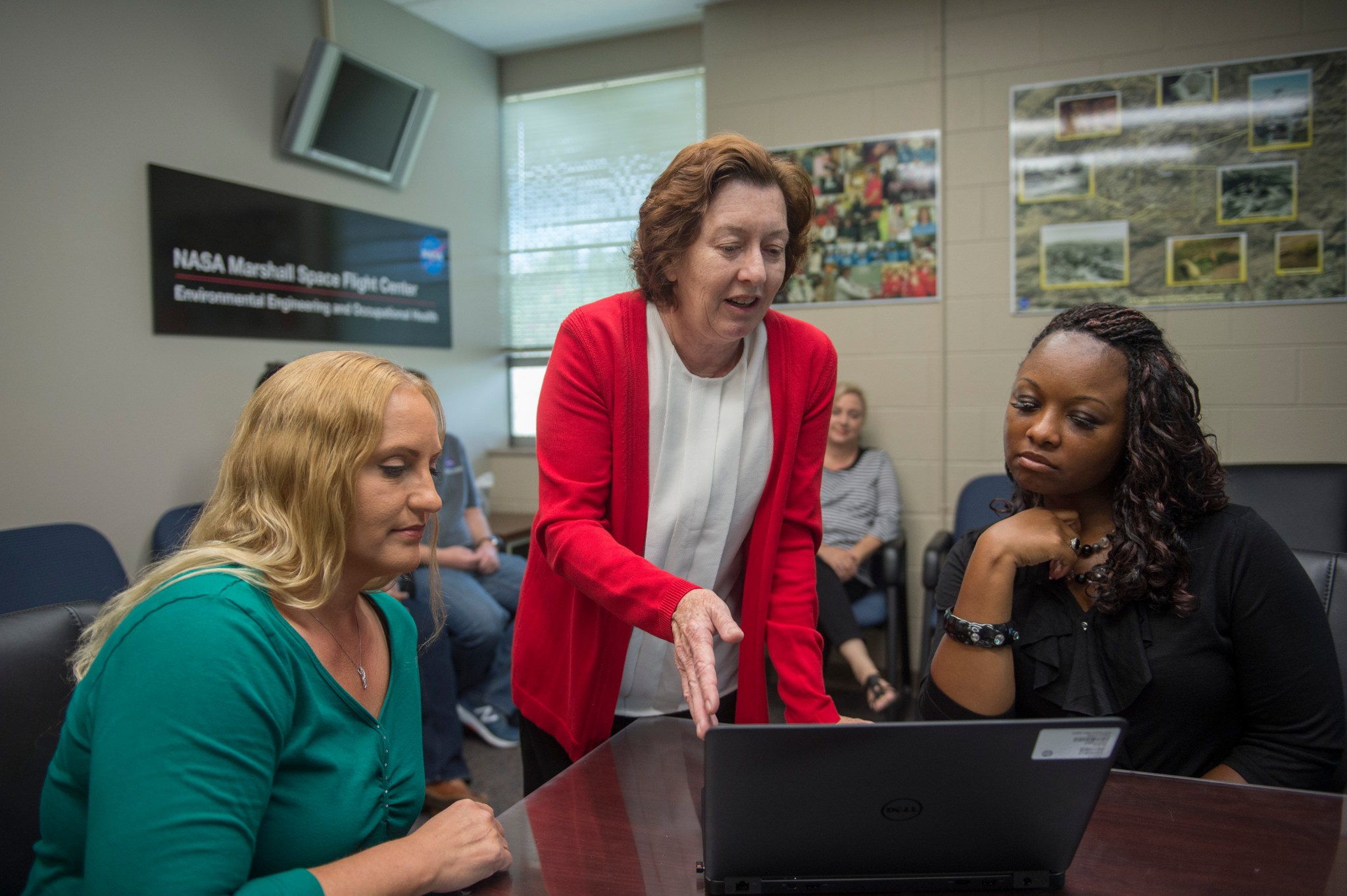
Daily through April 22, Marshall’s Environmental Engineering & Occupational Health Office is posting Earth Day at Home resources and learning opportunities to help team members create safe, sustainable and greener work environments — at a time when spare bedrooms and kitchen tables are serving as temporary offices, said Donna Leach, Marshall’s lead sustainability engineer.
Content on the Earth Day at Home page offers practical tips, including how to identify Earth-friendly solvents and cleaning techniques, improve water conservation at home and cultivate pollinator gardens, or plants which strengthen the ecosystem by promoting strong genetic reproduction and biodiversity. Marshall’s Green Team — sustainability advocates representing organizations centerwide — also post the quarterly “Green Spot” newsletter there, offering environmental news briefs and sustainability tips.
The new website also spotlights ways NASA’s mission in space positively impacts Earth’s environment and human lives everywhere — from researching global air quality from space and developing green insulation for new rockets to fighting wildfires and evaluating hurricane intensity.
“Tackling the environmental hurdles of living and working in space and pursuing scientific answers to the mysteries of the cosmos help Marshall researchers turn satellite data and studies aboard the International Space Station into practical solutions to some of Earth’s most pressing challenges,” Leach said.
Webpage articles and videos come from Leach and other EEOH team members, and from Marshall Earth, space and solar scientists and engineers whose work may not directly impact green practices or research at Marshall, but who maintain a personal commitment to sound environmental management and conservation. Local community members also are involved, submitting presentations and videos on their areas of expertise.
Leach hopes that communal sense of duty to the planet will continue to spread, even as team members shelter at home and conduct business via telework to check the spread of COVID-19.
“This is a perfect time to consider our commitment to understanding and protecting the fragile planet we live on, even as we look beyond it to new Artemis missions to the Moon and crewed voyages to Mars,” she said. “We have to work together to ensure those future explorers have a healthy, thriving world to come home to at journey’s end.”
There’s so much content posted to the Earth Day at Home pages — with more to come — that Leach said it’ll be “a little easier” bypassing the traditional Marshall Earth Day festivities this spring. For now.
“Wait until you see what’s in store for 2021,” she said.
Smith, an ASRC Federal/Analytical Services employee, supports the Office of Strategic Analysis & Communications.
STEM Office Works to Award Student Launch, Rover Challenge Teams
By Janet Sudnik
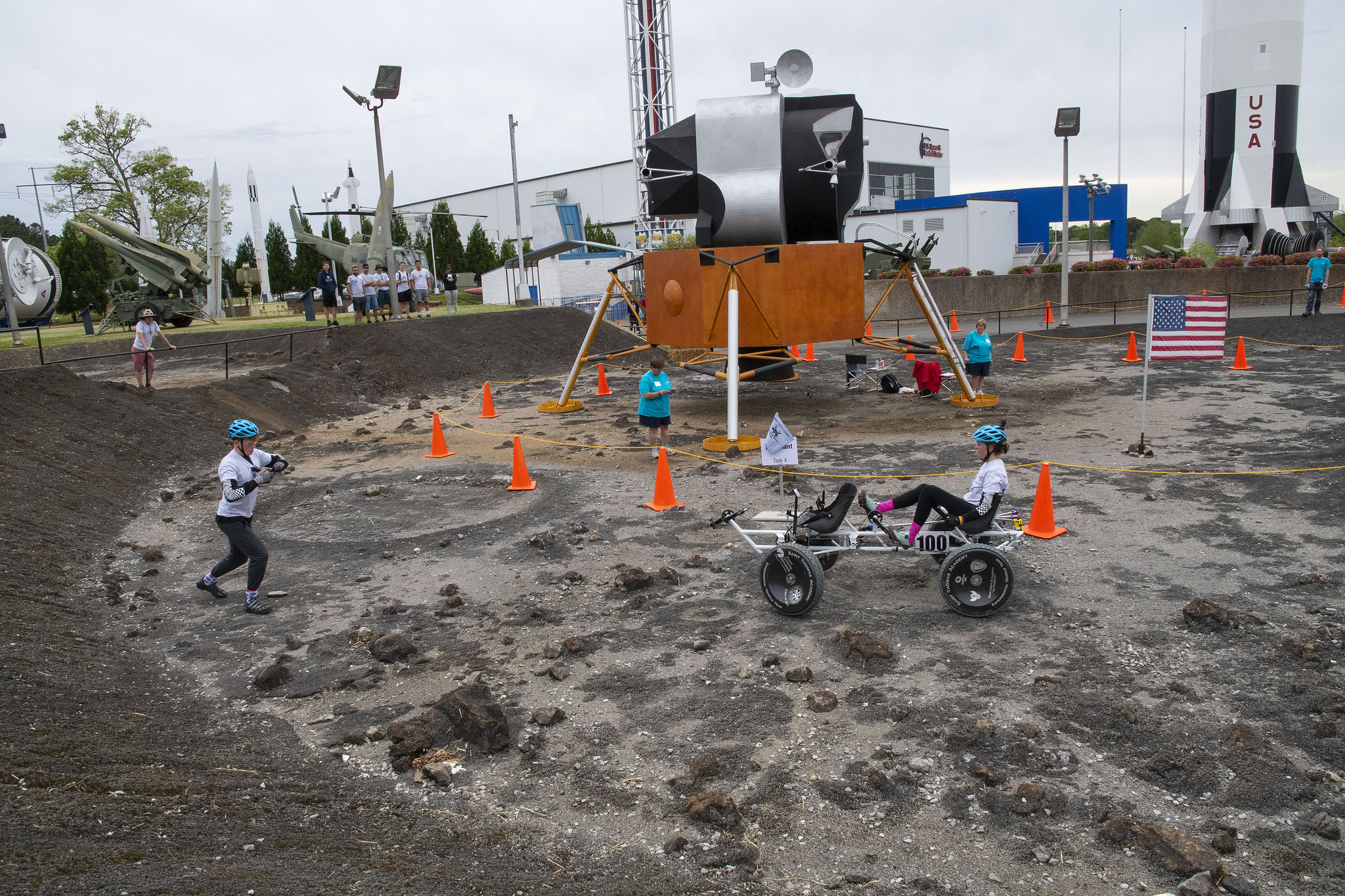
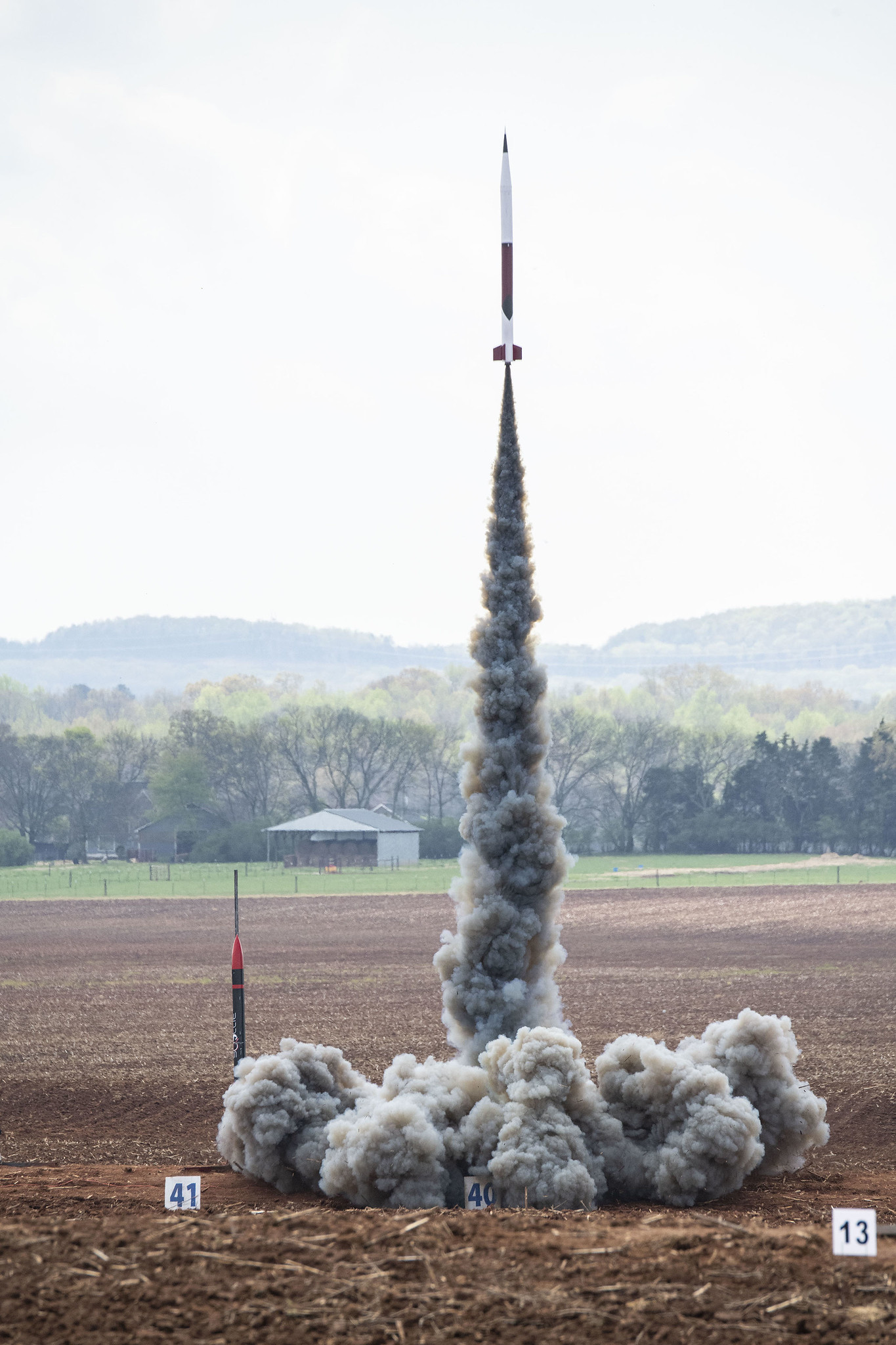
Spring has long been the season of rockets and rovers for NASA’s Marshall Space Flight Center and the surrounding community. For 20-plus years, two of NASA’s flagship education competitions — both Artemis Student Challenges — have taken place each April: the Student Launch rocket competition and the NASA Human Exploration Rover Challenge. This year, the global COVID-19 pandemic jeopardized both events, so NASA and partners moved quickly to assess and update them, keeping health and safety at the forefront.
As the pandemic began to put limitations on travel, and schools shifted to virtual operations or closed altogether, Marshall’s Office of STEM Engagement and event partners worked contingency plans and altered the challenge structures. The growing severity and reach of the outbreak ultimately meant cancellation of the face-to-face portions, but there is still much to celebrate, and awards to be given.
“Our OSTEM team has made great efforts to innovate and find ways to preserve as much of these competitions as possible in the face of these unprecedented conditions,” said Kevin McGhaw, program manager of Marshall’s Office of STEM Engagement. “We are proud to have such an agile and creative group that has prioritized safety and still found ways to maintain the spirit of these events.”
Even in the face of these challenges and changes, students have gained significant value from the research, engineering, teamwork and project tasks they have already completed.
Student Launch challenges teams to design, build, test and ultimately fly a payload and high-powered amateur rocket. Rockets had been scheduled to fly the first weekend in April, so the challenge team modified the timeline to avoid the need to gather in groups. Instead, they will use data and scores already collected during design and flight reviews, and will be awarding monetary prizes and honors virtually.
“With the rapidly worsening situation, we acted as quickly and thoughtfully as possible to adjust the competition in ways that allow us to reward the teams’ hard work while keeping everyone as safe as possible,” said Fred Kepner, an education program specialist at Marshall and lead for Student Launch.
Shortly after, the Human Exploration Rover Challenge team took similar action. For this competition, which is held on the grounds of the U.S. Space & Rocket Center, teams design, engineer and test a human-powered rover, culminating with a head-to-head challenge on a course simulating terrain found on the Moon and Mars. Despite not being able to proceed with the final test of their vehicle, much of the work has already been done by teams, and is able to be scored. Awards and recognitions for this year will be presented virtually. When teams return next year, they will also be commemorating the 50th anniversary of the Lunar Roving Vehicle’s first operations on the surface of the Moon.
“Although we are disappointed that it isn’t feasible to host the in-person competition this year, we are pleased to still award several prizes and honors to the teams who have put the work in all year,” said Julie Clift, an education specialist at Marshall and lead for Rover Challenge. “We are looking forward to welcoming teams back in 2021, which will definitely be a cause for celebration.”
Sudnik is a public affairs officer in the Office of Strategic Analysis & Communications.
Apollo 13: The Successful Failure
By Brian Odom
On April 11, 1970, the powerful Saturn V rocket carrying the Apollo 13 mission launched from NASA’s Kennedy Space Center, propelling astronauts Jim Lovell, Fred Haise and Jack Swigert on what was intended to be humanity’s third lunar landing.
The mission to explore the Fra Mauro region of the Moon did not go as planned. What many viewed as a “routine” mission soon had millions around the globe glued to television sets, watching and hoping for a positive outcome for one of the most intense episodes in the history of space exploration.
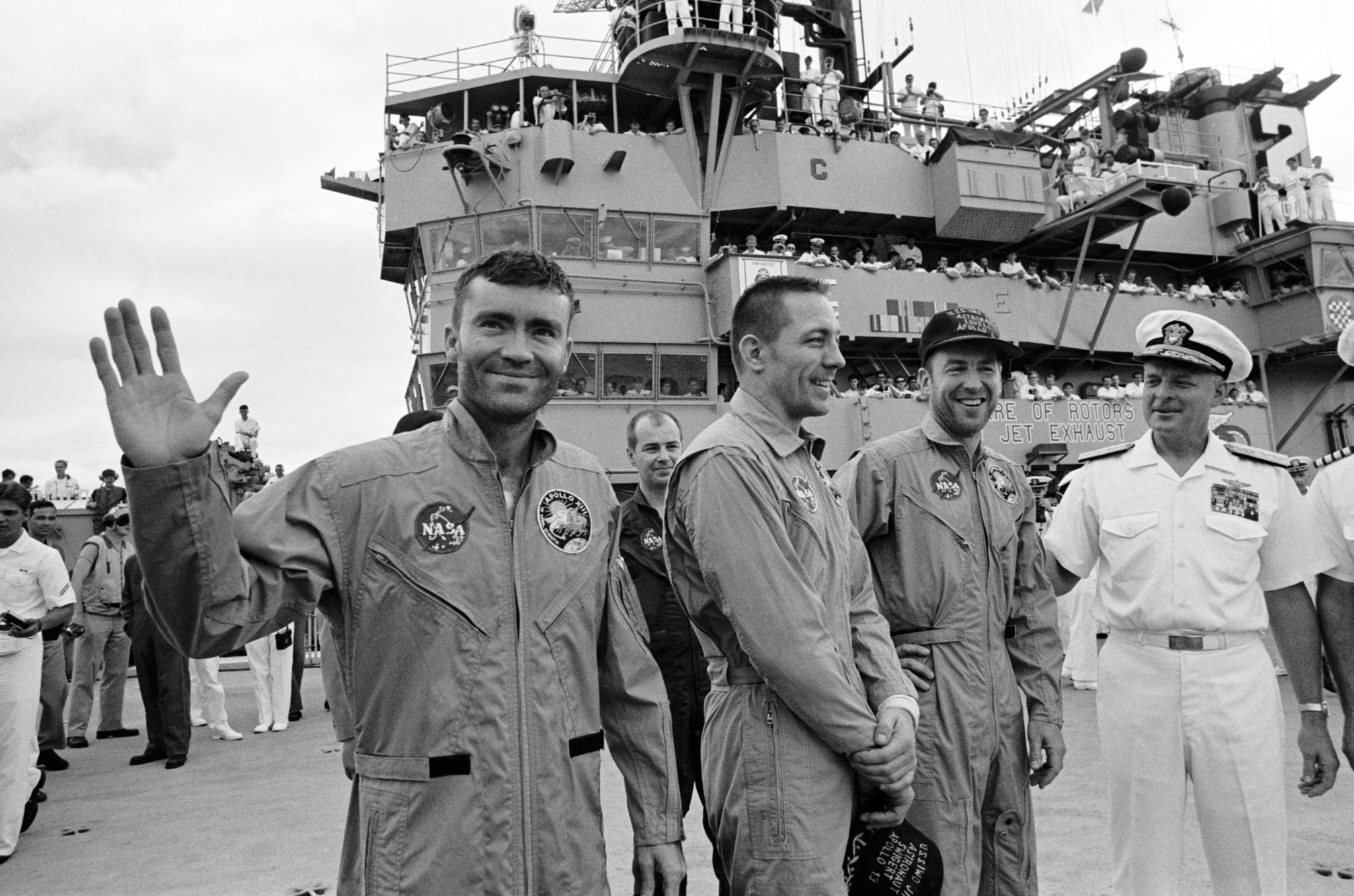
The public’s attention had increasingly turned away from the Apollo missions, due to the overwhelming success of the Apollo 11 mission in July 1969 and the subsequent Apollo 12 mission, combined with expanding public protests over the Vietnam War. Shrinking budgets threatened many of the remaining Apollo missions, leading eventually to the cancellation of Apollo 18, 19 and 20. Those of the superstitious persuasion noted that even the Apollo 13 launch suffered from all the unlucky lore surrounding the mission’s number. Some validity to those fears proved warranted when a measles scare prompted the replacement of command module pilot Ken Mattingly with Swigert.
The mission got off to an auspicious start when, during launch, the Saturn V experienced an early shutdown of one of the second stage’s J-2 engines. Burning the remaining four engines an additional 34 seconds longer and the third stage an additional nine seconds placed Apollo 13 in the proper orbit. Afterward, the mission settled into what increasingly felt like a routine journey, prompting Joe Kerwin, the capsule communicator at the Manned Spacecraft Center in Houston, to proclaim that the “spacecraft is in good shape” and that he and everyone else in the control room were “bored to tears down here.” Minutes later, the explosion of oxygen tank No. 2 ended those feelings.
As warning lights in the cabin indicated the loss of two of the three fuel cells, the crew communicated to Houston that they had a big problem. Looking to the outside of the command module Odyssey, Lovell noticed they were “venting something out into the … into space.” That venting was the lifeblood of the mission — oxygen. The crew discovered that the explosion in tank No. 2 had also damaged tank No. 1 — a problem which made use of the fuel cells impossible, threatening the eventual loss of all electrical power and water. With the lunar landing now erased from the equation, both the astronauts aboard Apollo 13 and NASA personnel on the ground worked tirelessly around the clock to develop solutions that would allow the astronauts to return home safely.
The immediate response plan was to enter what was known as “lifeboat mode.” The lunar module Aquarius became central to efforts to save the beleaguered spacecraft and crew. Aquarius’ full oxygen tank and descent engine both proved critical in keeping the crew alive and returning them to Earth. Along with the extreme shortage of water and electrical power, the crew also encountered dangerous levels of carbon dioxide. Plenty of lithium hydroxide canisters, designed to remove the gas from the spacecraft, were on hand in the command module, but those square canisters were not compatible with the round openings in the Aquarius. Engineers in Houston were able to devise a method for fitting a “square peg in a round hole.”
After taking a free-return-to-Earth trajectory and using the Sun as an alignment star for navigation, the Apollo 13 crew soon found themselves approaching home. One final problem remained — powering up the command module after its seemingly long hiatus. Under normal conditions, the process of writing new procedures would take three months. Houston had three days. One major issue concerned whether cold condensation on the instrumentation would short circuit when power returned. Years later, Haise remembered the command module looking as though someone had “sprayed it with a hose” and that the crew had to “wipe everything off with a towel.” Fortunately, activation caused no arching. Why not? The answer could be found in the lessons learned from the Apollo 1 fire that killed three astronauts in January 1967, after which a major redesign was undertaken to add increased insulation for better protection of the wiring.
On April 17, 1970, the crew said goodbye to Aquarius and returned to Earth — splashing down in the Pacific Ocean near Samoa. Only when the crew was safely aboard the recovery ship USS Iwo Jima could everyone at NASA and around the world finally begin to exhale. The lessons learned from the successful failure of Apollo 13 were rapidly applied to the remaining Apollo missions and continue to guide safety and mission assurance at NASA today.
Odom is the historian at NASA’s Marshall Space Flight Center.
This Week in NASA History: Apollo 16 Launches – April 16, 1972
This week in 1972, Apollo 16 launched from NASA’s Kennedy Space Center. Apollo 16 was the second of three science-oriented missions planned for the Apollo Program. The mission included a Lunar Roving Vehicle, developed by NASA’s Marshall Space Flight Center, to transport astronauts and materials on the Moon. Today, Marshall is playing a vital role in the Artemis program by developing the Space Launch System, the backbone of NASA’s exploration plans and the only rocket capable of sending humans to the Moon and Mars. The NASA History Program is responsible for generating, disseminating and preserving NASA’s remarkable history and providing a comprehensive understanding of the institutional, cultural, social, political, economic, technological and scientific aspects of NASA’s activities in aeronautics and space. For more pictures like this one and to connect to NASA’s history, visit the Marshall History Program’s webpage. (NASA)



























